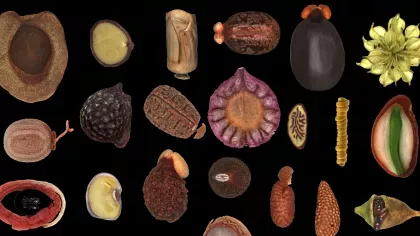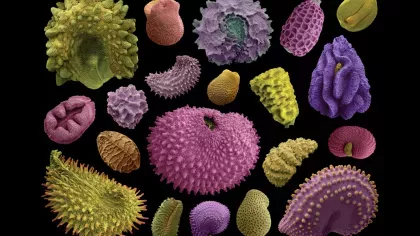20 December 2019
Revealing the hidden mysteries of holly
Although a common species in the UK, the seeds of holly are particularly challenging to germinate.

Holly is one of those species which is unequivocally linked with Christmas.
It’s embedded within Christmas songs and adorns the inside of houses and the front of many a Christmas card with a sprinkling of snow and a robin or two.
But there are many things about this common species which remain a mystery. We are only now beginning to reveal holly’s hidden secrets, such as what conditions the seeds need to germinate.

Collecting holly seeds
Since the UK National Tree Seed Project (UKNTSP) began in early 2013, we have been collecting holly (Ilex aquifolium) seeds from across the UK to secure genetic diversity.
Thanks to funding from Players of People’s Postcode Lottery, to date we have 60 holly collections totalling over 385,000 seeds.
But we don’t just store the collected seed. We need to know if the seed is alive and how to germinate it to ensure that new plants can be generated.
Generally, when a seed collection arrives at the Millennium Seed Bank, we x-ray a representative sample to check whether the seeds are full or empty as an initial indication of quality.
Once the seed has been stored, germination tests are undertaken. However, this requires an understanding of the environmental conditions needed to break dormancy break and enable germination.
For some species this is easy and already known, but for others, including holly, it poses more of a challenge. Particularly if the seed has a dormancy mechanism.


Sleeping seeds
Seed dormancy is generally believed to be a survival mechanism. It enables the seed to control (to a certain extent) when it germinates, maximising the chance that the seedling will survive.
For example, in fire-prone habitats some species (such as the Australian shrub Acacia suaveolens) need heat from fire to break dormancy. This brief exposure to a high temperature enables the seeds to germinate after a fire when there is reduced competition in the environment.
For many UK tree species, dormancy breaking is linked with temperature, so the seed is effectively able to detect the season.
For instance, many species require a period of cold chilling before they will germinate, i.e. they need to overwinter, so the germination occurs in the spring when the chance of frosts occurring and damaging the seedling is reduced.
Holly is believed to have morphophysiological dormancy.
This means that, at the point of dispersal from the mother plant, the embryo of the seed is not fully developed, it needs time to fully mature (the “morpho” part) and some form of temperature cycling before the seeds are able to germinate (the “physiological” part).


Years of testing
When I (Rachael) started to work on holly germination a few years ago I never expected such a common species would be so tricky to germinate.
Indications from the scientific literature suggested that germination typically takes two to three years following dispersal.
In addition, as the seeds of holly are dispersed by birds, there had been some suggestion that the seed may need some form of disruption to the seed coat, or covering structures, to mimic the effect of bird stomach acid for germination to occur.
I set up germination tests on the holly seeds based on UK climate conditions, changing the conditions following seasonal changes, but no germination occurred so I waited.
I had just about given up when finally, more than three and a half years and several winter temperature cycles later, there was suddenly a flurry of germinated seeds. Up to 90 per cent of the seeds had germinated in just three weeks.
Good things really do come to those who wait.
Acknowledgments
Thanks to funding from Players of People’s Postcode Lottery.

References
Arrieta, S. and Suárez, F. (2004). Germination and seed bank depletion of holly (Ilex aquifolium L.) in four microhabitat types. Seed Science Research 14: 305-313.
Hyde, H.A. (1961). Welsh timber trees: native and introduced. National Museum of Wales. Cardiff.
Peterken, G.F. and Lloyd, P.S. (1967). Ilex aquifolium L.. Journal of Ecology 55: 841-858.




